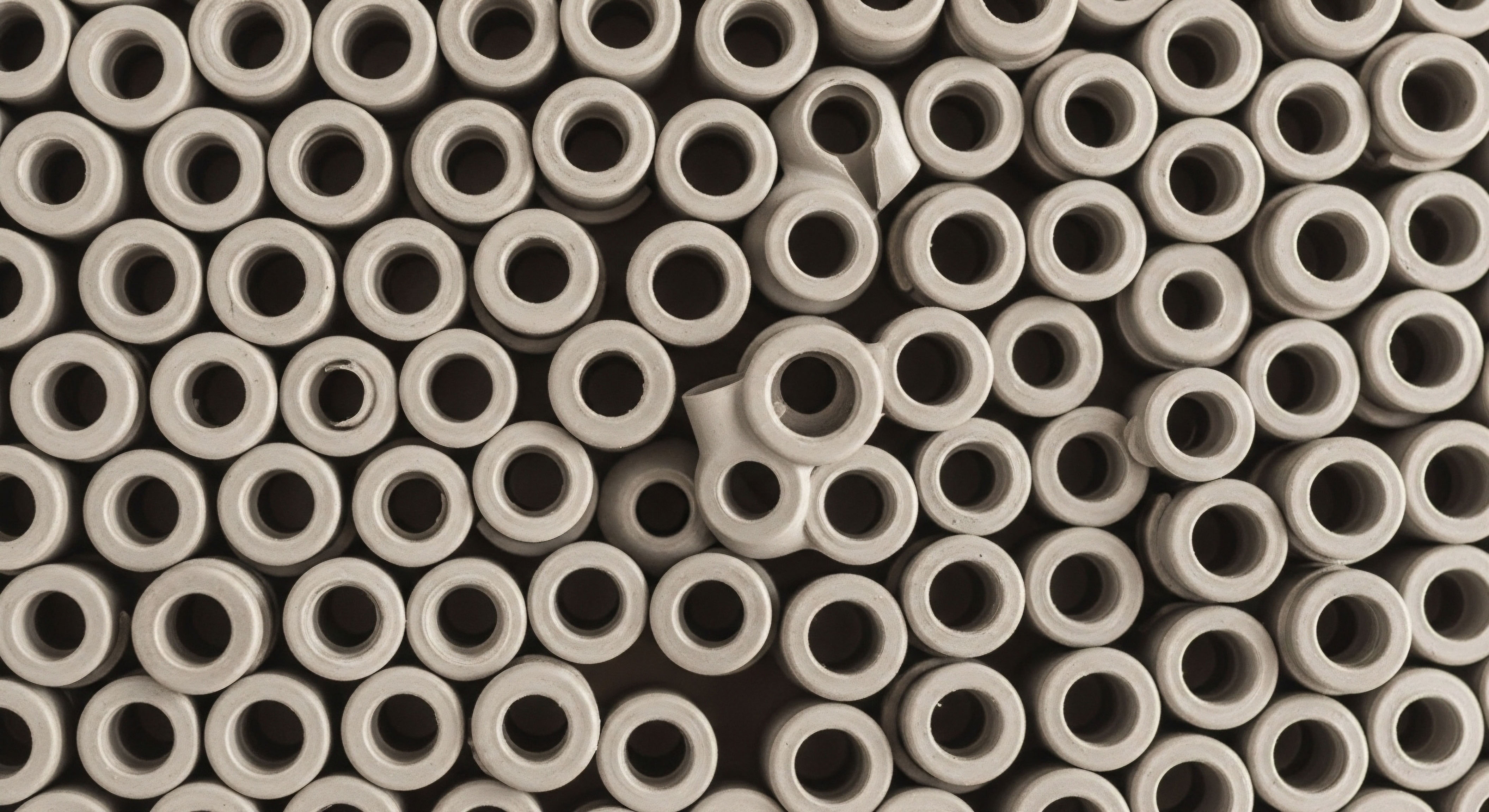

Fundamentals
The feeling of being out of sync with your own body is a deeply personal and often frustrating experience. You may notice persistent fatigue that sleep does not resolve, shifts in your mood that seem to come from nowhere, or changes in your body composition despite your best efforts with diet and exercise.
These experiences are valid, and they often point toward the intricate communication network within your body known as the endocrine system. This system, a collection of glands that produce hormones, acts as the body’s internal messaging service, sending chemical signals that regulate everything from your metabolism and energy levels to your stress response and reproductive health. Understanding this system is the first step toward reclaiming your vitality.
Your daily life provides the raw materials and instructions that direct this complex hormonal symphony. The food you consume, the quality of your sleep, the physical demands you place on your body, and the way you manage stress are not passive activities.
They are active biological inputs that directly inform how your hormones are produced, transported, and received by your cells. A therapeutic protocol, such as hormone replacement, introduces a powerful new signal into this environment. Its effectiveness is profoundly connected to the foundational stability of the system it enters. Therefore, addressing your lifestyle is a primary and essential component of any strategy aimed at hormonal wellness.

The Four Pillars of Hormonal Foundation
To appreciate how lifestyle interventions can shape your hormonal health, it is helpful to view the body’s endocrine function as being supported by four structural pillars. When these pillars are strong, the entire system is more resilient and responsive to therapeutic guidance. When they are compromised, the system becomes less stable, and the signals from therapies can become distorted or less effective.

Pillar 1 Nutrition the Building Blocks of Hormones
Hormones are synthesized from the nutrients you consume. Steroid hormones, including testosterone and estrogen, are derived from cholesterol, a type of fat. This means that adequate intake of healthy fats is a prerequisite for their production. Proteins provide the amino acids necessary for creating peptide hormones like insulin and growth hormone, as well as thyroid hormones.
Micronutrients such as zinc, magnesium, and B vitamins act as essential cofactors, helping the enzymatic machinery of your cells assemble these hormones correctly. A diet lacking in these fundamental components deprives your body of the basic building blocks required for hormonal balance.

Pillar 2 Exercise the Great Modulator
Physical activity is a potent regulator of hormonal health. Resistance training, for instance, can stimulate the production of anabolic hormones like testosterone and growth hormone, which are vital for maintaining muscle mass, bone density, and metabolic function. Aerobic exercise improves your cells’ sensitivity to insulin, a key hormone for regulating blood sugar.
Poor insulin sensitivity can create a cascade of hormonal disruptions, affecting everything from ovarian function in women to testosterone levels in men. Consistent movement helps ensure that hormonal messages are received clearly and efficiently by your cells.
Your daily choices are not separate from your hormonal health; they are the very language your endocrine system understands.

Pillar 3 Sleep the Master Regulator
The body’s hormonal rhythms are deeply tied to the sleep-wake cycle, or circadian rhythm. During deep sleep, the body performs critical restorative functions, including the release of growth hormone, which is essential for tissue repair. Sleep deprivation, on the other hand, leads to elevated levels of cortisol, the primary stress hormone.
Chronically high cortisol can suppress the production of sex hormones and disrupt the delicate balance of the entire endocrine system. Aiming for 7-9 hours of quality sleep per night is a non-negotiable aspect of hormonal maintenance.

Pillar 4 Stress Management the Cortisol Connection
Chronic stress places the body in a constant state of high alert, characterized by the overproduction of cortisol. The body prioritizes the production of cortisol during stressful periods, often at the expense of other hormones like testosterone and progesterone. This is because cortisol and sex hormones are synthesized from the same precursor molecule, pregnenolone.
The body effectively “steals” the raw materials for sex hormones to manufacture more stress hormones. Implementing stress-management techniques like mindfulness, deep breathing, or yoga helps to lower cortisol levels, freeing up the necessary resources for balanced hormone production.
These four pillars create the biological environment into which any hormonal therapy is introduced. A well-nourished, physically active, well-rested, and stress-managed body is primed to respond optimally to therapeutic interventions. Conversely, a body struggling with poor nutrition, inactivity, sleep deprivation, or chronic stress will likely exhibit a blunted or unpredictable response to the same therapy. The journey to hormonal balance, therefore, begins with the foundational choices you make every day.


Intermediate
When you embark on a hormonal optimization protocol, such as Testosterone Replacement Therapy (TRT) or peptide therapy, you are introducing precise biochemical signals to recalibrate your body’s systems. The success of these interventions is directly influenced by the biological landscape they encounter. Lifestyle factors act as powerful amplifiers or dampeners of these therapeutic signals.
Understanding the specific mechanisms through which diet, exercise, and stress management interact with your therapy can empower you to become an active participant in your own health outcome.
A clinical protocol works by supplying a specific hormone or a secretagogue that encourages your body to produce its own hormones. For example, in male TRT, weekly injections of Testosterone Cypionate provide a direct supply of testosterone. However, the amount of that testosterone that is biologically available to your tissues depends on other factors, many of which are under your control.
One such factor is Sex Hormone-Binding Globulin (SHBG), a protein that binds to testosterone in the bloodstream, rendering it inactive. Lifestyle choices can significantly influence SHBG levels, thereby determining the efficacy of your treatment.

How Do Lifestyle Choices Directly Augment Therapy Outcomes?
The interaction between your daily habits and your therapeutic protocol is not abstract; it occurs at a tangible, biochemical level. By optimizing these lifestyle inputs, you can enhance the intended effects of your therapy and mitigate potential side effects.

Nutritional Synergy with Hormonal Protocols
Your diet provides the essential cofactors and building blocks that support hormonal pathways. For individuals on TRT, certain dietary strategies can improve the therapy’s effectiveness.
- Protein Intake ∞ Adequate protein consumption is essential for supporting the muscle protein synthesis stimulated by testosterone. Consuming lean proteins helps provide the necessary amino acids for muscle repair and growth, maximizing one of the primary benefits of TRT.
- Healthy Fats ∞ Cholesterol is the precursor to all steroid hormones. A diet rich in healthy fats from sources like avocados, nuts, and olive oil supports the body’s natural endocrine functions and provides the raw materials for hormone production.
- Micronutrient Support ∞ Specific vitamins and minerals are critical for testosterone production and function. Zinc and Vitamin D are two of the most important. Zinc is involved in the enzymatic processes that synthesize testosterone, while Vitamin D receptors are found on the cells in the testes that produce testosterone.
- Managing Insulin ∞ A diet high in refined carbohydrates and sugars can lead to insulin resistance. High insulin levels are associated with lower SHBG, which might seem beneficial, but insulin resistance itself is linked to inflammation and lower testosterone production, creating a complex and often detrimental hormonal environment.

Exercise as a Potentiator of Hormonal Therapy
Physical activity works in concert with hormonal therapies to produce superior results compared to therapy alone. A 2016 pilot study published in PubMed Central demonstrated that combining exercise with TRT led to greater improvements in testosterone levels and symptoms than TRT alone. The benefits were also more durable after the therapy was discontinued in the exercise group.
| Exercise Type | Mechanism of Action | Interaction with Therapy (TRT & Peptides) |
|---|---|---|
| Resistance Training | Stimulates muscle protein synthesis, increases androgen receptor density in muscle cells. | Enhances the muscle-building (anabolic) effects of testosterone and growth hormone peptides. More receptors mean the hormonal signal is received more effectively. |
| High-Intensity Interval Training (HIIT) | Improves insulin sensitivity, boosts metabolism, and can increase endogenous testosterone production. | Improves the body’s metabolic environment, making it more responsive to therapy. Better insulin sensitivity helps manage body composition and reduces inflammation. |
| Moderate Aerobic Exercise | Reduces cortisol levels, improves cardiovascular health, and aids in weight management. | Helps mitigate potential side effects of therapy by improving overall health markers. Lowering stress through exercise supports a better testosterone-to-cortisol ratio. |
Optimizing your lifestyle transforms you from a passive recipient of therapy into an active architect of your hormonal health.

The Impact of Sleep and Stress on Therapeutic Efficacy
The restorative processes that occur during sleep are fundamental to the success of any hormonal protocol. For those using growth hormone peptides like Sermorelin or Ipamorelin, the therapy is designed to augment the natural pulse of growth hormone released during deep sleep. Poor sleep quality directly undermines the efficacy of these treatments. If you are not entering deep sleep, you are missing the primary window of opportunity for these peptides to work.
Similarly, chronic stress and the resultant high cortisol levels can counteract the benefits of TRT. Cortisol is a catabolic hormone, meaning it breaks down tissue. Testosterone is an anabolic hormone, meaning it builds tissue. When cortisol is chronically elevated, it creates a physiological environment that opposes the very effects you are trying to achieve with testosterone therapy.
This can lead to frustrating results, where despite adequate testosterone levels in the blood, you may not experience the expected improvements in muscle mass, energy, or well-being.
By actively managing stress and prioritizing sleep, you are creating a biological environment that is conducive to anabolism and restoration. This allows the therapeutic signals from your protocol to exert their full effects without being counteracted by opposing physiological states. Your lifestyle choices, therefore, are not merely supportive; they are an integral part of the therapeutic process itself.


Academic
The relationship between lifestyle interventions and hormonal therapy outcomes extends beyond simple additive effects into a complex, bidirectional interplay rooted in systems biology. A particularly compelling area of research that illuminates this connection is the study of the estrobolome. The estrobolome is the aggregate of enteric bacterial genes capable of metabolizing estrogens.
This collection of gut microbes does not merely exist within the host; it actively participates in the regulation of systemic estrogen levels, thereby influencing the pathophysiology of numerous conditions and modulating the efficacy of hormonal therapies, particularly in women.
Understanding the estrobolome requires an appreciation of estrogen metabolism. Estrogens are produced primarily in the ovaries and adrenal glands, circulate through the body to exert their effects, and are eventually conjugated in the liver to prepare them for excretion.
This conjugation process attaches a molecule (like glucuronic acid) to the estrogen, rendering it water-soluble and inactive, and earmarking it for elimination via bile into the gut. Here, the estrobolome intervenes. Certain gut bacteria produce an enzyme called β-glucuronidase. This enzyme can deconjugate the estrogen, essentially cutting off the “inactive” tag and allowing the free, active estrogen to be reabsorbed back into circulation through the intestinal wall. This process is known as the enterohepatic circulation of estrogens.

The Estrobolome as a Modulator of Hormonal Homeostasis
The composition and health of the gut microbiome directly determine the level of β-glucuronidase activity and, consequently, the amount of estrogen that is reactivated and reabsorbed. A healthy, diverse microbiome tends to maintain a balanced level of β-glucuronidase activity, contributing to normal estrogen homeostasis. However, a state of dysbiosis ∞ an imbalance in the gut microbiota ∞ can significantly alter this process.
- High β-glucuronidase activity ∞ An overgrowth of certain bacteria can lead to an excess of β-glucuronidase. This results in increased deconjugation and reabsorption of estrogens, leading to elevated levels of circulating estrogen. This state of estrogen dominance is associated with conditions like endometriosis, premenstrual syndrome (PMS), and an increased risk of estrogen-receptor-positive breast cancer.
- Low β-glucuronidase activity ∞ Conversely, a depleted microbiome, perhaps due to antibiotic use or a low-fiber diet, may exhibit reduced β-glucuronidase activity. This leads to less estrogen reabsorption and lower circulating estrogen levels, which can contribute to symptoms associated with menopause, obesity, and cardiovascular issues.
The gut microbiome functions as a critical endocrine organ, actively regulating steroid hormones and influencing therapeutic outcomes.

How Do Lifestyle Interventions Shape the Estrobolome?
Lifestyle factors, particularly diet, are the primary drivers of the gut microbiome’s composition and function. This provides a powerful mechanism through which individuals can influence their hormonal balance and the outcomes of hormonal therapies.
A diet rich in fiber from diverse plant sources provides the necessary prebiotics to nourish a healthy microbiome. Fermented foods introduce beneficial probiotic bacteria. Conversely, a diet high in processed foods, sugar, and unhealthy fats can promote dysbiosis, altering the estrobolome and disrupting estrogen metabolism. Chronic stress can also negatively impact the gut microbiome by altering gut motility and increasing intestinal permeability (“leaky gut”), which can lead to systemic inflammation and further disrupt hormonal signaling.
| Lifestyle Factor | Effect on Gut Microbiome | Impact on Estrobolome/Estrogen Levels | Clinical Relevance for Hormonal Therapy |
|---|---|---|---|
| High-Fiber Diet (Fruits, Vegetables, Legumes) | Increases microbial diversity. Provides prebiotics that feed beneficial bacteria. | Promotes a balanced estrobolome. Supports healthy estrogen detoxification and excretion. | Creates a stable baseline for estrogen levels, allowing for more predictable and effective dosing of female HRT (e.g. Progesterone, low-dose Testosterone). |
| High-Fat, High-Sugar Diet | Reduces microbial diversity. Promotes the growth of inflammatory bacteria. | Can lead to dysbiosis and elevated β-glucuronidase activity, causing estrogen dominance. | May counteract the intended balance of HRT, potentially requiring adjustments in therapy (e.g. addition of an aromatase inhibitor like Anastrozole) to manage excess estrogen. |
| Chronic Stress | Increases intestinal permeability. Alters gut motility and microbial composition. | Contributes to systemic inflammation, which can disrupt the hypothalamic-pituitary-gonadal (HPG) axis and alter estrogen metabolism. | Can create a pro-inflammatory state that blunts the therapeutic effects of hormonal and peptide therapies, making it harder to achieve desired outcomes. |
| Regular Exercise | Enhances microbial diversity and promotes the growth of beneficial bacteria. | Contributes to a healthier gut environment, supporting balanced estrogen metabolism. | Works synergistically with therapy by improving the underlying physiological systems that regulate hormones, including the gut-hormone axis. |
For a woman undergoing hormonal therapy for menopausal symptoms, the state of her estrobolome is of paramount importance. If her gut microbiome is dysbiotic and causing excess estrogen reabsorption, it could complicate her therapy, potentially leading to side effects or requiring additional interventions.
By adopting a lifestyle that fosters a healthy gut microbiome ∞ a diet rich in fiber, low in processed foods, and combined with stress management and regular exercise ∞ she can directly support the healthy metabolism of both her endogenous and supplemented hormones.
This creates a more stable and predictable physiological environment, allowing the therapeutic protocol to function as intended and yielding better clinical outcomes. The gut, therefore, is not a passive bystander in hormonal health; it is an active and modifiable participant.

References
- Quaresma, M. V. G. et al. “The Role of Diet and Exercise in the Treatment of Late-Onset Hypogonadism.” Reviews in Urology, vol. 22, no. 1, 2020, pp. 1-8.
- Baker, J. M. et al. “Estrogen-gut microbiome axis ∞ Physiological and clinical implications.” Maturitas, vol. 103, 2017, pp. 45-53.
- He, Y. et al. “The role of diet and exercise in testosterone replacement therapy.” Journal of Men’s Health, vol. 17, no. 4, 2021, pp. 128-135.
- Shin, J. et al. “Exercise improves the effects of testosterone replacement therapy and the durability of response after cessation of treatment ∞ a pilot randomized controlled trial.” The World Journal of Men’s Health, vol. 34, no. 2, 2016, pp. 109-116.
- Wilson, A. “How stress can affect your sleep.” Baylor College of Medicine, 2019.
- “Hormones & Gut Health ∞ The Estrobolome & Hormone Balance.” The Marion Gluck Clinic.
- “Balancing Estrogen ∞ Why the Gut Microbiome Matters.” Vibrant Wellness.
- “How Sleep Impacts Stress and Hormones.” Resilient Nutrition.
- “Diet and Exercise Influence on Hormone Therapy Effectiveness.” Bloom MedSpa.
- “The Role of Diet and Exercise in Low Testosterone Treatment.” North Dallas Wellness.

Reflection

Charting Your Own Biological Course
The information presented here provides a map of the intricate connections between your daily life and your internal hormonal world. It details the mechanisms and pathways that link the food you eat, the movement you perform, the rest you take, and the stress you manage to the very core of your physiological function.
This knowledge is a powerful tool. It shifts the perspective from one of passively receiving treatment to one of actively building a foundation for wellness. Your body is a dynamic system, constantly responding to the signals you provide.
Consider your own daily rhythms and routines. Where are the areas of strength? Where are the opportunities for fortification? The path to reclaiming vitality is a personal one, built upon a deep understanding of your unique biology. The science provides the principles, but you are the one who applies them.
This journey is about aligning your lifestyle with your biology to create an internal environment where health can be restored and optimized. The potential for change lies within the choices you make each day.



